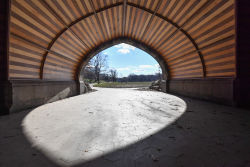Prospect Park
Maryland Monument
This Corinthian column topped by a marble orb commemorates the bravery of the Maryland 400, the company of Maryland soldiers who fought at Lookout Hill, in what would become Prospect Park, during the Battle of Long Island on August 27, 1776.
The Maryland 400, under the command of Lord Stirling (also known as General William Alexander), held off British General Cornwallis’s troops to allow General George Washington and his forces time to escape across Gowanus Creek. The mission was a success, though at a cost of 250 lives. The soldiers are buried at a plot on Third Avenue between 8th and 9th Streets just west of the park.
The monument was donated by the Maryland Society of the Sons of the American Revolution at an original cost of $3,000. The column was designed (free of charge) by noted architect Stanford White (1853–1906), who also designed the pedestals for other notable Prospect Park pieces such as the Panthers (1898) and Horse Tamers (1899). The main column is 12 feet high, constructed of polished granite, and topped by a marble ball resting on a bronze Corinthian capital (the design is recognizable as a Masonic emblem). The distinctive wrought-iron basket weave fencing surrounding the monument was added at a later date. The marble pedestal was donated by the Brooklyn Parks Department, and the inscription on the pedestal – "My God, What Brave Fellows I Must This Day Lose!" – is attributed to George Washington.
U.S. troops, patriotic societies, the 14th Regiment of the New York State National Guard, and members of the Grand Army of the Republic participated in the unveiling ceremony, which was held on August 27, 1895, the 119th anniversary of the battle. The mayors of both New York City and Brooklyn – as this was before the consolidation of the City in 1898 – were honored guests, along with the Lieutenant Governor. General Horace Porter, Ulysses Grant’s aide-de-camp during the Civil War, also attended the ceremony; Porter’s grandfather was a Revolutionary War General.
The monument was first restored in 1935-6 under the auspices of the Works Progress Administration. Additional work occurred in 1969. In 1991, with support from the Governor’s Commission on Maryland Military Monuments, the monument underwent a more thorough conservation, and the granite and marble pieces were repointed, the stone surfaces were cleaned, and the fence was repaired and restored. In 2008, the Citywide Monuments Conservation Program again restored the Maryland Monument, recreating numerous missing bronze letters, in an endeavor sponsored by the Maryland Historic Trust. Today, perched on its landscaped promontory, this elegant monument continues to be a reminder of the sacrifices made to establish a new nation.
Check out your park's Vital Signs
Clean & Safe
Green & Resilient
Empowered & Engaged Users
Share your feedback or learn more about how this park is part of a
Vital Park System











